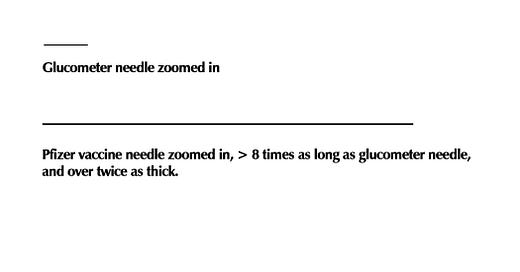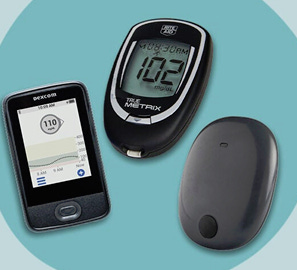Does any vaccine stay in the arm? No.
And every medical professional could have figured that out, if they had stopped to think about it. Injected liquid (of any kind) cannot simply ‘stay in the arm.’ Here’s why.
First, a diabetic’s daily experience
An estimated 8.5% to 10% of Americans have type 2 diabetes mellitus (DM2). This brings much of the entire US population into acquaintance with one or more diabetic people, and we may even be related to a diabetic or may even live in the same household. With such high prevalence, most adults, and all healthcare professionals, are aware of diabetics’ need to check their blood sugar frequently. Although there is now an electronic blood sugar monitor that has been helpful for checking blood sugar without a needle poke, the glucometer with needle is still the most common method. These are some glucometers:
To make it work, a very small needle, called a lancet, is used to elicit a drop of blood, which is then applied to the end of a test strip. The test strip is then inserted promptly into one end of the glucometer, which starts a chemical reaction between the person’s blood sugar (glucose) and of enzymes on the test strip. The glucometer then displays a number, as the 102 in the above photo, resulting from that chemical reaction. The number is the interpretation from that reaction as the amount of glucose in the person’s blood. But those details are merely introduction to glucometers, not important to my argument.
Here is the needle that is used in the glucometer, on the right in the photo below. It is 30 gauge, which is 0.312 millimeters thick, and it is 3 millimeters long.
A zoomed in lancet:
Now if you ask any diabetic, no matter where they poke themselves, even on the fingertips, which are some of the most distant extremities from the heart, they never fail to produce a drop of blood when they are poked with this item. (Unless years of manual labor made thick, tough callouses, and then the needle poke is done on an uncalloused side of a finger.)
Now let’s compare this with the needle used for Pfizer vaccine administration. It is 22 to 25 gauge, which is wider than the glucometer lancet. The Pfizer needle is 1 to 1.5 inches in length. Let’s say it is on the smaller side, 22 gauge and one inch long.
So the glucometer needle is 3 millimeters long and 30 gauge thick, which is 0.312 millimeters thick in outer diameter. (Millimeter thickness from gauge may be seen here.)
And the Pfizer vaccine needle is one inch = 25.4 mm long and 22 gauge, which is 0.718 mm thick in outer diameter.
Here is a zoomed-in size comparison:
So even a tiny needle, such as a glucometer lancet will not fail to elicit a drop of blood. You don’t even have to map out where the blood vessels run under the skin. Just pick any spot, and be confident that you will strike a leak, no matter where you poke. You don’t have to repeatedly stab yourself with the tiny needle above, in order to find a rare blood vessel. No matter where you use the glucometer lancet, unless calloused or pathologically coagulated or dehydrated, a drop of blood will travel outward, the entire length of the lancet, and then appear on the skin’s surface.
Why can we be so sure of eliciting a drop of blood as easily as throwing a dart at the side of a barn? Because the capillaries are only 100 micrometers = 0.1 millimeters apart, which is a third of the thickness of even the glucometer lancet, and 1/7 the thickness of the Pfizer vaccine needle. And for every tenth of a millimeter that needle advances through flesh, 3 to 7 more capillaries are blown.
What does this mean for access to the bloodstream?
It means that multiple blood vessels have been pierced, and are now leaking, no matter where you poke.
So any needle pierce of skin, even as shallow as three millimeters, will allow penetration of the one-millimeter thick epidermis – which does not have blood vessels - and will plunge the needle all the way to the hub, through the 3-millimeter thick dermis, which does have blood vessels, and then through that to the subcutaneous layer, or hypodermis, which has larger blood vessels. Cleveland Clinic illustrates the layers here, with their respective blood vessels:

And, we know from the diabetics’ experience of not having to repeatedly stab themselves to try to find a drop of blood, that blood vessels are disrupted every single time, even by the tiny, thin and short needle above, and to such a great extent, that a drop of blood oozes all the way out past the lancet’s length, and onto the surface of the skin.
So then we see that if the Pfizer vaccine needle is over 8 times as long, and over twice as wide as the lancet, then all the more blood vessels, including some of the larger and deeper ones in the subcutaneous layer are accessed. (For larger needle use, a Z-track technique is often used, in part to minimize such blood spillage on the surface.) The larger and deeper vessels are farther apart, and are less likely to be accessed in any single needle poke. However, it is often forgotten that the ubiquitous and densely distributed capillaries are there also, which is necessary for all of the body’s cells, both superficial and deep, to be nourished by the blood. Otherwise, they would die. So any needle access to both superficial (by glucometer lancet) and deep (by vaccine needle) will assuredly disrupt capillaries and very possibly some venules as well.
And then 0.3 ml of liquid is deposited right there, at the site of the broken blood vessels.
Is it any wonder then that any injection of any liquid at all can access the whole body? Except for the non-mixing of oil and water, do you know of any other adjacent liquids that will NOT mix together?
A red blood cell takes less than a minute to complete a journey from a capillary to the heart and back to a capillary again. The liquid plasma that carries it is on the same path. Injections of liquids then go with the flow.
So yes, the mRNA vaccine or any other vaccine or injection travels the path of accessing the entire bloodstream.
The body is 55% to 60% water. And then a liquid is deposited in this semi-solid material by a vaccine. Is it any more likely to stay in one spot than if you add some water to food that you are preparing? So perhaps cooks could also have guessed that a vaccine would not simply stay in the arm.
We also know of distribution of injected liquid from men who get testosterone shots. Does the deltoid site of injection get more muscular or hairy, but not the rest of the body? No, injected liquid accesses blood and lymph.
Liquid with liquid: Go with the flow
In medical school we physicians learned centuries-long knowledge of circulation and lymph drainage. Every cell in the body is less than a fingernail's thickness away from the nearest blood vessel, actually within 50 to 100 micrometers away, as needed for the nourishment to sustain that cell’s life. Innumerable capillaries are pierced and disrupted during vaccination by needle piercing flesh to a depth of an inch or similar. (Worse vaccine reactions are possibly correlated with a larger blood vessel accidentally pierced.)
If local vs systemic were the main consideration regarding the COVID vaccines, where mRNA had killed all the test animals, and no coronavirus vaccine had ever been successful, and cationic (positively charged) LNPs create havoc at cell membranes.... If local arm vs systemic considerations were primary, any healthcare professional could have rung the alarm, and we all should have, and a number of us did. (It seems I was first with comprehensive warnings of expected damage to multiple bodily organs by these vaccines on 2/21/21, https://www.primarydoctor.org/covidvaccine. – Readers, please correct me if I’m wrong about that. I don’t mind being 2nd, 3rd or umpteenth.)
Possibly there were laypeople with respect to medicine who had not heard that prior mRNA experiments and prior attempted coronavirus vaccines had killed all the test animals, nor that cationic lipid nanoparticles were known to be toxic to multiple bodily organs. There were even many healthcare professionals who did not know these essential facts. It is possible that caution was thrown to the wind by both laypeople and healthcare professionals after hearing - and astonishingly even believing - the assertion that the vaccine would stay in the arm.
As we can see from the above evidence, no injected liquid can be reasonably expected to stay in the shoulder or arm, as it was alleged by the pandemic & vaccine industrial complex.
We would do well to remember the exquisitely intricate circulation in humans and the rest of the animal kingdom prior to accepting any more experimental or otherwise sketchy injections.







Exactly Dr Huber! I'm certainly not a medical expert and even with my "some college" education I was able to figure this out and explain to my peers using nature itself as an example. A bee sting can cause anaphylaxis, a mosquito bite can cause malaria (and other ailments) just to name a couple of natural "injections" that can circulate in the body and cause a reaction. To think that we have so-called "experts" out there that can't figure this out is an absolute embarrassment.
There's also this: Whatever you put on your skin can be detected in your blood within minutes. So yeah, the idea that an injection stays in the arm is ludicrous!